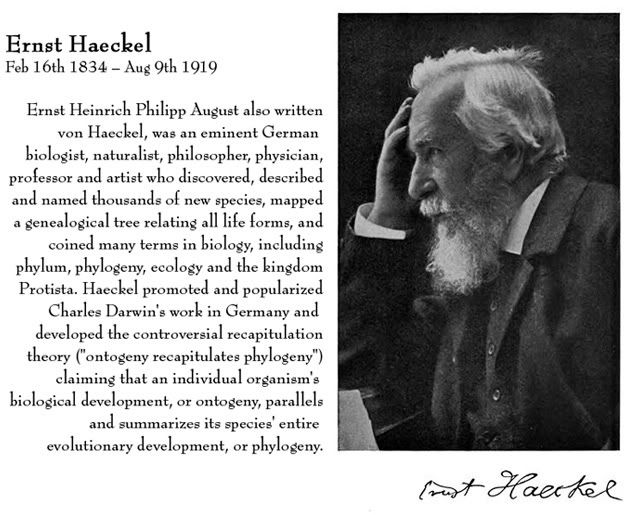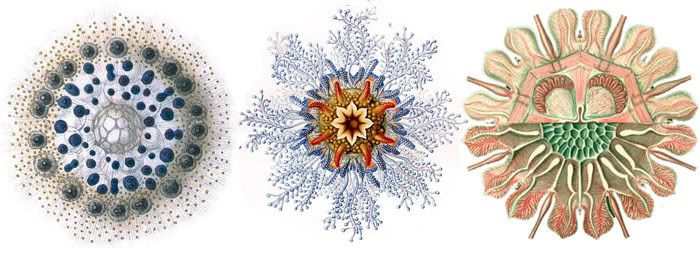Artists are frequently drawn to images by Ernst Haeckel, although perhaps not this diagram.
 |
Genealogical tree suggested by Haeckel (1866) Here's a link to a book written by Haeckel, translated from German which you may like to take a look at: |
 |
| Haeckel |
A Visit to Ceylon by Ernst Haeckel translated by Clara Bell 1883
 |
| Found here. |
For an excellent brief pictorial introduction read more here.
Ernst Haeckel's recapitulation theory
During the late 19th century, Ernst Haeckel's recapitulation theory, or biogenetic law, was widely accepted. This theory was often expressed as "ontogeny recapitulates phylogeny", i.e. the development of an organism exactly mirrors the evolutionary development of the species. Haeckel's early version of this hypothesis [that the embryo mirrors adult evolutionary ancestors] has since been rejected, and the hypothesis amended as the embryo's development mirroring embryos of its evolutionary ancestors. Most modern biologists recognize numerous connections between ontogeny and phylogeny, explain them using evolutionary theory, or view them as supporting evidence for that theory. Donald I. Williamson suggested that larvae and embryos represented adults in other taxa that have been transferred by hybridization (the larval transfer theory).[8][9] However, Williamson's views do not represent mainstream thought in molecular biology,[10]and there is a significant body of evidence against the larval transfer theory.[11]
Engaging blogger Velma Bolyard reminded me in her comment at the last post of something that was a key feature of my first week just gone on residency at the Institute of Molecular BioScience here in Brisbane...
vocabulary
Without an adequate vocabulary + effort to be acquainted with the concepts its hard to progress. Whether I will find a month affords me the kind of progress I desire is another thing... but words are streaming in and being added to my list at a great rate. This crash course is being generously provided in the main by Joshua Mylne who's profile I've borrowed from the IMB website:
Plant molecular biology and genetics for human health
Josh Mylne
Plants have more to offer than food. Not only do we find them aesthetically inspiring, but they are the source of most medicines, the fibres we wear and the materials with which we build our houses. Plants can also be an ideal system for studying basic biological phenomena. We are using Arabidopsis thaliana, a model plant used by over 16,000 labs worldwide, to overcome barriers to protein drug production and to discover the mode of action for market drugs. In the first, we are examining the machinery employed by sunflower to process a small drug-like protein ring from within a much larger seed protein. We use genetic and transgenic approaches in Arabidopsis to understand and improve their ability to process these protein rings. In the second, we are using the surprisingly close relationship between plants and the malarial parasite Plasmodium falciparum to understand how an antimalarial drug works before the parasite finds a way to overcome it, which is essential if we are ever going to predict how malaria may acquire resistance to drugs in use today.
Projects include:
|
In addition many others have been most helpful. Research assistants to Joshua Mylne, Amy Argyros and Aurelie Chanson, demonstrated Lab work on Friday and accompanied me to a most stimulating lecture by Robert J Henry, director of the newly formed University Institute: QAAFI or Queensland Alliance for Agricultural and Food Innovation. I scribbled notes on ten pages during the hour-long talk and noted with keen interest his focus on indigenous plants and detailed inclusion of Biodiversity in his rationale for new directions. In fact... this talk contained numerous threads I've been following for some time, wondering how I might gain more info, especially for this state, re some of the questions that have emerged for me.


Go to this page to find a flyer on the International Fascination of Plants Day...
the reason for this current collaboration organised through Joshua Mylne at the IMB.
On the Vocab list so far:
Sessile or sessility: In botany, sessility (meaning "sitting", used in the sense of "resting on the surface") is a characteristic of plants whose flowers or leaves are borne directly from the stem.
Synteny: is a newly coined term meaning "on the same ribbon"; Greek: σύν, syn = along with + ταινία, tainiā = band. A concept relating to genetic linkage.
Phylogeny: This simple diagram provides a useful overview.
 |
| Image found here |

and by way of comparison this more complex algorithm - above - found here.
Phylogenetics: In biology, phylogenetics ( /faɪlɵdʒɪˈnɛtɪks/) is the study of evolutionary relation among groups of organisms (e.g. species,populations), which is discovered through molecular sequencing data and morphological data matrices. The termphylogenetics derives from the Greek terms phyle (φυλή) and phylon (φῦλον), denoting “tribe” and “race”;[1] and the termgenetikos (γενετικός), denoting “relative to birth”, from genesis (γένεσις) “origin” and “birth”.[2]
/faɪlɵdʒɪˈnɛtɪks/) is the study of evolutionary relation among groups of organisms (e.g. species,populations), which is discovered through molecular sequencing data and morphological data matrices. The termphylogenetics derives from the Greek terms phyle (φυλή) and phylon (φῦλον), denoting “tribe” and “race”;[1] and the termgenetikos (γενετικός), denoting “relative to birth”, from genesis (γένεσις) “origin” and “birth”.[2]
Taxonomy, the classification, identification, and naming of organisms, is richly informed by phylogenetics, but remains methodologically and logically distinct.[3] The fields of phylogenetics and taxonomy overlap in the science of phylogenetic systematics — one methodology, cladism (also cladistics) shared derived characters (synapomorphies) used to create ancestor-descendant trees (cladograms) and delimit taxa (clades).[4][5] In biological systematics as a whole, phylogenetic analyses have become essential in researching the evolutionary tree of life.
Phylogenomics: Phylogenomics is the intersection of the fields of evolution and genomics.[1] The term has been used in multiple ways to refer to analysis that involves genome data and evolutionary reconstructions. It expands earlier phylogenetics. Phylogenomics draws information by comparing entire genomes, or at least large portions of genomes. Phylogenetics is smaller in scope and compares and analyzes only single genes, or a very small number of genes.[2] Three major areas fall under phylogenomics:
- Prediction of gene function
- Establishment and clarification of evolutionary relationships
- Prediction and retracing lateral gene transfer
NB: All found at Wiki!
 |
| Image link from this blog: Bioephemera - Jessica Palmer has a PhD in Molecular Biology and has been blogging about the intersection of art and biology since 2006. NB: image link given by Palmer is no longer current... so here is no title or name of artist supplied. |
Of course I could keep going - there's endless material I keep finding.... but its already too much informations i'm sure.
Till next time, thanks for popping in here!
S
Till next time, thanks for popping in here!
S


5 comments:
Sounds like the residency is very fruitful! Love the work of Haeckel, thanks for new words. I've never seen that tree diagram by Haeckel, I really like it visually! Kind of a tree of life kind of thing, beautiful.
Thanks V...
its rather a loaded post... wrote it days ago and just put it up last night.
Contains such a lot of leads... so glad you liked reading on Haeckel...that tree image is rather fascinating indeed!
I must say its fascinating to gradually be expanding the vocal and understanding of the development of scientific thinking around plants... puts so much more perspective on why the field is exploding now!
S
Fantastic! Lots to learn and contemplate here.
THere's been such a lot to take in Rosaria...
finding historical context can only helps ground this new learning.
Glad to share,
S
what an amazing project! so many interesting images and ideas.
Post a Comment